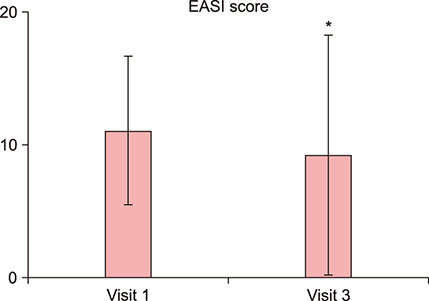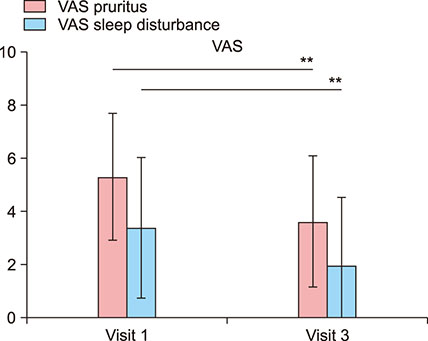Ann Dermatol.
2018 Jun;30(3):304-308. 10.5021/ad.2018.30.3.304.
The Beneficial Effect of Korean Red Ginseng Extract on Atopic Dermatitis Patients: An 8 Weeks Open, Noncomparative Clinical Study
- Affiliations
-
- 1Department of Dermatology, The Catholic University of Korea, Incheon St. Mary's Hospital, Incheon, Korea. drchos@yahoo.co.kr
- 2Department of Dermatology, Hallym University Kangnam Sacred Heart Hospital, Seoul, Korea.
- KMID: 2419171
- DOI: http://doi.org/10.5021/ad.2018.30.3.304
Abstract
- BACKGROUND
Atopic dermatitis (AD) is a chronic or chronically relapsing, eczematous, severely pruritic inflammatory skin disorder. Korean red ginseng (KRG) has been shown previously to exhibit diverse biological effects including anti-inflammatory and antipruritic effects in a murine model.
OBJECTIVE
We aimed to investigate the beneficial effects of KRG on AD patients, to determine whether there was improvement in disease severity, skin barrier function, pruritus and sleep disturbance relief.
METHODS
An open, noncomparative clinical study that utilized KRG tablets (500 mg/tablet) was conducted. This study included 41 patients with mild to moderate AD diagnosed by the Korean atopic dermatitis guidelines. Three visits to the hospital at days 1, 28±7, and 56±7 for evaluation were made. The effects of KRG were assessed by measuring eczema area and severity index (EASI) score, transepidermal water loss (TEWL), the visual analogue scale (VAS), total amount of topical agents used in recent 8 weeks and investigator global assessment (IGA).
RESULTS
Patients taking KRG tablets showed significant decreases in EASI score and TEWL, and the VAS of pruritus and sleep disturbance were significantly reduced. The amount of topical agents used was reduced but not by a statistically significant amount. IGA at the third visit showed improvement of AD compared to the second visit, but the difference was not statistically significant.
CONCLUSION
KRG can be safely used as a health food to achieve clinical improvement of AD as well as improving overall quality of life, and has potential for further development.
MeSH Terms
Figure
Reference
-
1. Novak N, Leung DY. Advances in atopic dermatitis. Curr Opin Immunol. 2011; 23:778–783.
Article2. Homey B, Steinhoff M, Ruzicka T, Leung DY. Cytokines and chemokines orchestrate atopic skin inflammation. J Allergy Clin Immunol. 2006; 118:178–189.
Article3. Szegedi A, Baráth S, Nagy G, Szodoray P, Gál M, Sipka S, et al. Regulatory T cells in atopic dermatitis: epidermal dendritic cell clusters may contribute to their local expansion. Br J Dermatol. 2009; 160:984–993.
Article4. Hinz D, Bauer M, Röder S, Olek S, Huehn J, Sack U, et al. Cord blood Tregs with stable FOXP3 expression are influenced by prenatal environment and associated with atopic dermatitis at the age of one year. Allergy. 2012; 67:380–389.
Article5. Shibata S, Fujita M, Itokawa H, Tanaka O, Ishii T. Studies on the constituents of Japanese and Chinese crude drugs. XI. Panaxadiol, a sapogenin of ginseng roots. Chem Pharm Bull (Tokyo). 1963; 11:759–761.
Article6. Bae EA, Trinh HT, Yoon HK, Kim DH. Compound K, a metabolite of ginsenoside Rb1, inhibits passive cutaneous anaphylaxis reaction in mice. J Ginseng Res. 2009; 33:93–98.
Article7. Ro JY, Ahn YS, Kim KH. Inhibitory effect of ginsenoside on the mediator release in the guinea pig lung mast cells activated by specific antigen-antibody reactions. Int J Immunopharmacol. 1998; 20:625–641.
Article8. Lee JH, Cho SH. Korean red ginseng extract ameliorates skin lesions in NC/Nga mice: an atopic dermatitis model. J Ethnopharmacol. 2011; 133:810–817.
Article9. Cho E, Cho SH. Effects of Korean red ginseng extract on the prevention of atopic dermatitis and its mechanism on early lesions in a murine model. J Ethnopharmacol. 2013; 145:294–302.
Article10. Hong J, Buddenkotte J, Berger TG, Steinhoff M. Management of itch in atopic dermatitis. Semin Cutan Med Surg. 2011; 30:71–86.
Article11. Koo J, Arain S. Traditional Chinese medicine in dermatology. Clin Dermatol. 1999; 17:21–27.
Article12. Matsuda H, Samukawa K, Kubo M. Anti-inflammatory activity of ginsenoside ro. Planta Med. 1990; 56:19–23.13. Park EK, Choo MK, Kim EJ, Han MJ, Kim DH. Antiallergic activity of ginsenoside Rh2. Biol Pharm Bull. 2003; 26:1581–1584.
Article14. Lee HJ, Cho SH. Therapeutic effects of Korean red ginseng extract in a murine model of atopic dermatitis: anti-pruritic and anti-inflammatory mechanism. J Korean Med Sci. 2017; 32:679–687.
Article15. Lee CH, Yu HS. Biomarkers for itch and disease severity in atopic dermatitis. Curr Probl Dermatol. 2011; 41:136–148.
Article
- Full Text Links
- Actions
-
Cited
- CITED
-
- Close
- Share
- Similar articles
-
- Effect of Ginseng Extract on Blood Lipids and Atherosclerosis
- Anti-inflammatory and Anti-oxidative Effects of Korean Red Ginseng Extract in Human Keratinocytes
- An Experimental Study on the Protective Effects of Ginseng Extract to Oxygen Toxicity
- Effect of Red Ginseng Extract on Lipid Peroxidation in Streptozotocin-induced Diabetic Rats
- Therapeutic Effects of Korean Red Ginseng Extract in a Murine Model of Atopic Dermatitis: Anti-pruritic and Anti-inflammatory Mechanism




